2011 Peugeot 308 CC weight
[x] Cancel search: weightPage 5 of 292

3
CONTENTS
Direction indicators 101
Hazard warning lamps 101
Horn 102
Emergency or assistance call 102
Tyre under-infl ation detection 103
Braking assistance systems 104
Trajectory control systems 105
Front seat belts 107
Airbags 110
Child seats 114
ISOFIX child seats 119�„
�„
�„
�„
�„
�„
�„
�„
�„
�„
�„
SAFETY 101 �Π121
Parking brake 122
Manual gearbox 122
Gear shift indicator 123
Hill start assist 124
Automatic gearbox 125
Stop & Start 128
Speed limiter 131
Cruise control 133
Parking sensors 135�„
�„
�„
�„
�„
�„
�„
�„
�„
DRIVING 122 �Π136
Bonnet 138
Running out of fuel (Diesel) 139
Petrol engines 140
Diesel engines 141
Checking levels 142
Checks 144�„
�„
�„
�„
�„
�„
CHECKS 137 �Π145
Temporary puncture repair kit 146
Changing a wheel 151
Changing a bulb 155
Changing a fuse 160
Battery 166
Energy economy mode 168
Changing a wiper blade 169
Towing the vehicle 169
Towing a trailer 171
Very cold climate screen 172
Accessories 172�„
�„
�„
�„
�„
�„
�„
�„
�„
�„
�„
PRACTICAL
INFORMATION 146 �Π173
Petrol engines 174
Weights (petrol) 175
Diesel engines 176
Weights (Diesel) 177
Dimensions 178
Identifi cation markings 179�„
�„
�„
�„
�„
�„
TECHNICAL
DATA 174 �Π180
AUDIO EQUIPMENT
and TELEMATICS 181 �Π278
VISUAL
SEARCH 279 �Π282
ALPHABETICAL
INDEX 283 �Π287
Emergency or assistance 181
Peugeot Connect Media 185
Peugeot Connect Navigation 229
Peugeot Connect Sound 261�„
�„
�„
�„
7
89
1011
Page 41 of 292
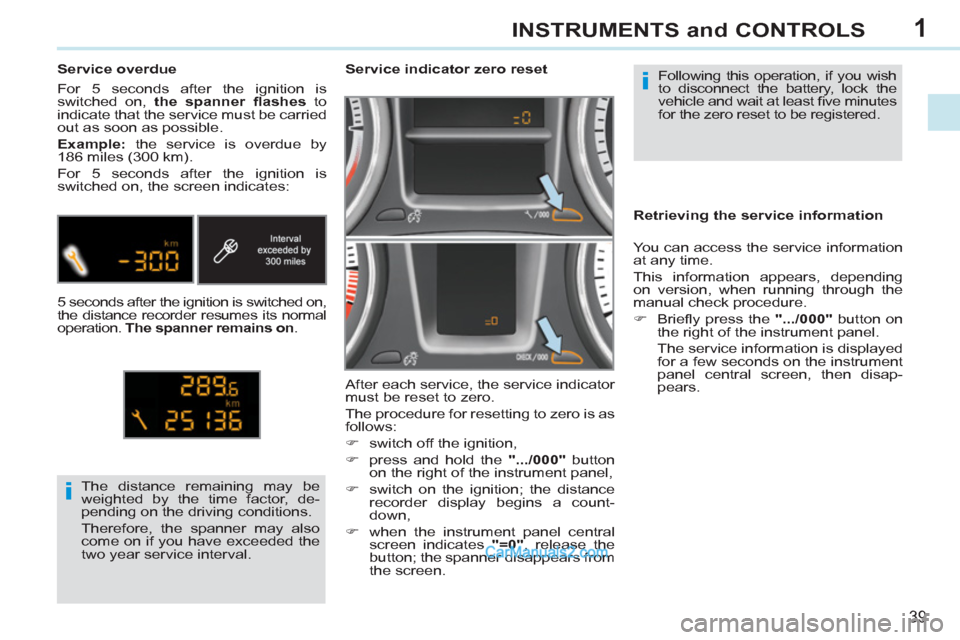
1
i
i
39
INSTRUMENTS and CONTROLS
Following this operation, if you wish
to disconnect the battery, lock the
vehicle and wait at least fi ve minutes
for the zero reset to be registered.
Service indicator zero reset
After each service, the service indicator
must be reset to zero.
The procedure for resetting to zero is as
follows:
�)
switch off the ignition,
�)
press and hold the ".../000"
button
on the right of the instrument panel,
�)
switch on the ignition; the distance
recorder display begins a count-
down,
�)
when the instrument panel central
screen indicates "=0"
, release the
button; the spanner disappears from
the screen. The distance remaining may be
weighted by the time factor, de-
pending on the driving conditions.
Therefore, the spanner may also
come on if you have exceeded the
two year service interval.
Service overdue
For 5 seconds after the ignition is
switched on, the spanner fl ashes
to
indicate that the service must be carried
out as soon as possible.
Example:
the service is overdue by
186 miles (300 km).
For 5 seconds after the ignition is
switched on, the screen indicates:
5 seconds after the ignition is switched on,
the distance recorder resumes its normal
operation. The spanner remains on
.
Retrieving the service information
You can access the service information
at any time.
This information appears, depending
on version, when running through the
manual check procedure.
�)
Briefl y press the ".../000"
button on
the right of the instrument panel.
The service information is displayed
for a few seconds on the instrument
panel central screen, then disap-
pears.
Page 116 of 292
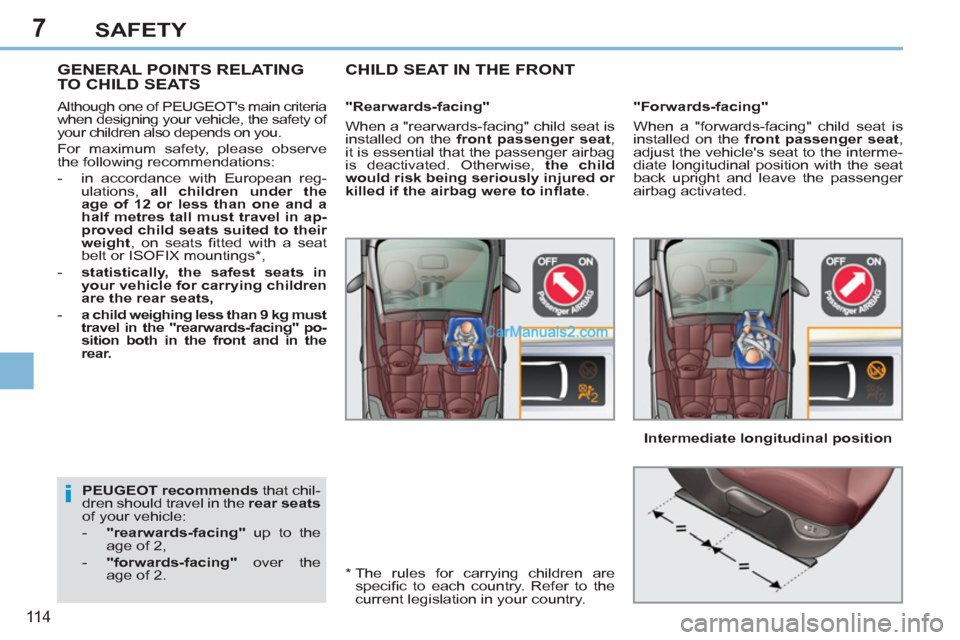
7
i
11 4
SAFETY
PEUGEOT recommends
that chil-
dren should travel in the rear seats
of your vehicle:
- "rearwards-facing"
up to the
age of 2,
- "forwards-facing"
over the
age of 2.
GENERAL POINTS RELATING
TO CHILD SEATS CHILD SEAT IN THE FRONT
"Forwards-facing"
When a "forwards-facing" child seat is
installed on the front passenger seat
,
adjust the vehicle's seat to the interme-
diate longitudinal position with the seat
back upright and leave the passenger
airbag activated.
"Rearwards-facing"
When a "rearwards-facing" child seat is
installed on the front passenger seat
,
it is essential that the passenger airbag
is deactivated. Otherwise, the child
would risk being seriously injured or
killed if the airbag were to infl ate
.
*
The rules for carrying children are
specifi c to each country. Refer to the
current legislation in your country. Although one of PEUGEOT's main criteria
when designing your vehicle, the safety of
your children also depends on you.
For maximum safety, please observe
the following recommendations:
- in accordance with European reg-
ulations, all children under the
age of 12 or less than one and a
half metres tall must travel in ap-
proved child seats suited to their
weight
, on seats fi tted with a seat
belt or ISOFIX mountings * ,
- statistically, the safest seats in
your vehicle for carrying children
are the rear seats,
- a child weighing less than 9 kg must
travel in the "rearwards-facing" po-
sition both in the front and in the
rear.
Intermediate longitudinal position
Page 119 of 292
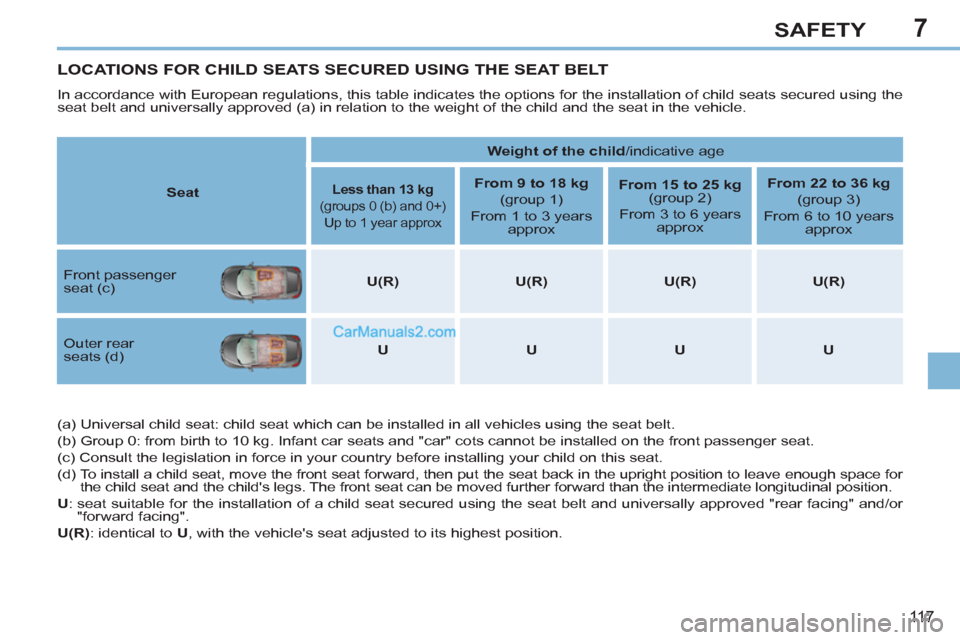
7
11 7
SAFETY
LOCATIONS FOR CHILD SEATS SECURED USING THE SEAT BELT
In accordance with European regulations, this table indicates the options for the installation of child seats secured using the
seat belt and universally approved (a) in relation to the weight of the child and the seat in the vehicle.
(a) Universal child seat: child seat which can be installed in all vehicles using the seat belt.
(b) Group 0: from birth to 10 kg. Infant car seats and "car" cots cannot be installed on the front passenger seat.
(c) Consult the legislation in force in your country before installing your child on this seat.
(d) To install a child seat, move the front seat forward, then put the seat back in the upright position to leave enough space for
the child seat and the child's legs. The front seat can be moved further forward than the intermediate longitudinal position.
U
: seat suitable for the installation of a child seat secured using the seat belt and universally approved "rear facing" and/or
"forward facing".
U(R)
: identical to U
, with the vehicle's seat adjusted to its highest position.
Seat
Weight of the child
/indicative age
Less than 13 kg
(groups 0 (b) and 0+)
Up to 1 year approx
From 9 to 18 kg
(group 1)
From 1 to 3 years
approx
From 15 to 25 kg
(group 2)
From 3 to 6 years
approx
From 22 to 36 kg
(group 3)
From 6 to 10 years
approx
Front passenger
seat (c)
U(R)
U(R)
U(R)
U(R)
Outer rear
seats (d)
U
U
U
U
Page 123 of 292
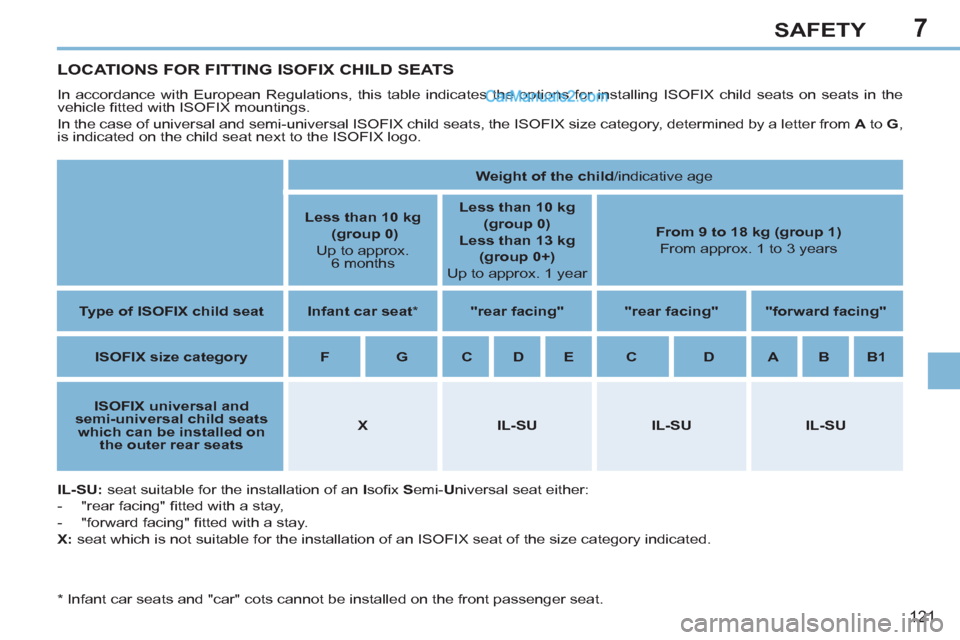
7
121
SAFETY
LOCATIONS FOR FITTING ISOFIX CHILD SEATS
In accordance with European Regulations, this table indicates the options for installing ISOFIX child seats on seats in the
vehicle fi tted with ISOFIX mountings.
In the case of universal and semi-universal ISOFIX child seats, the ISOFIX size category, determined by a letter from A
to G
,
is indicated on the child seat next to the ISOFIX logo.
IL-SU:
seat suitable for the installation of an I
sofi x S
emi- U
niversal seat either:
- "rear facing" fi tted with a stay,
- "forward facing" fi tted with a stay.
X:
seat which is not suitable for the installation of an ISOFIX seat of the size category indicated.
Weight of the child
/indicative age
Less than 10 kg
(group 0)
Up to approx.
6 months
Less than 10 kg
(group 0)
Less than 13 kg
(group 0+)
Up to approx. 1 year
From 9 to 18 kg (group 1)
From approx. 1 to 3 years
Type of ISOFIX child seat
Infant car seat
*
"rear facing"
"rear facing"
"forward facing"
ISOFIX size category
F
G
C
D
E
C
D
A
B
B1
ISOFIX
universal and
semi-universal
child seats
which can be installed on
the
outer rear seats
X
IL-SU
IL-SU
IL-SU
* Infant car seats and "car" cots cannot be installed on the front passenger seat.
Page 171 of 292
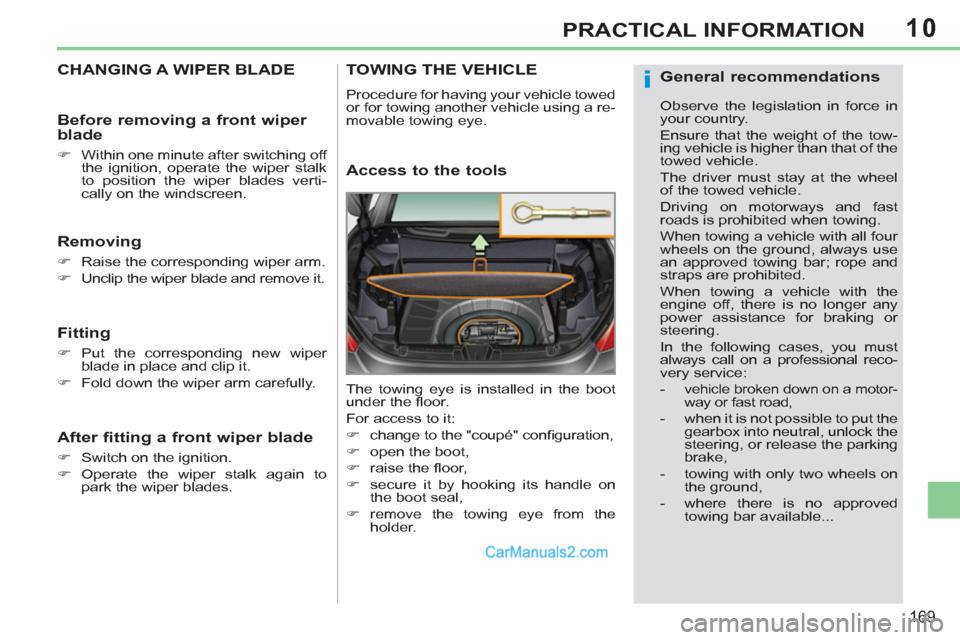
10
i
169
PRACTICAL INFORMATION
CHANGING A WIPER BLADE
Removing
�)
Raise the corresponding wiper arm.
�)
Unclip the wiper blade and remove it.
Fitting
�)
Put the corresponding new wiper
blade in place and clip it.
�)
Fold down the wiper arm carefully.
Before removing a front wiper
blade
�)
Within one minute after switching off
the ignition, operate the wiper stalk
to position the wiper blades verti-
cally on the windscreen.
After fitting a front wiper blade
�)
Switch on the ignition.
�)
Operate the wiper stalk again to
park the wiper blades.
TOWING THE VEHICLE
Procedure for having your vehicle towed
or for towing another vehicle using a re-
movable towing eye.
Access to the tools
The towing eye is installed in the boot
under the fl oor.
For access to it:
�)
change to the "coupé" confi guration,
�)
open the boot,
�)
raise the fl oor,
�)
secure it by hooking its handle on
the boot seal,
�)
remove the towing eye from the
holder.
General recommendations
Observe the legislation in force in
your country.
Ensure that the weight of the tow-
ing vehicle is higher than that of the
towed vehicle.
The driver must stay at the wheel
of the towed vehicle.
Driving on motorways and fast
roads is prohibited when towing.
When towing a vehicle with all four
wheels on the ground, always use
an approved towing bar; rope and
straps are prohibited.
When towing a vehicle with the
engine off, there is no longer any
power assistance for braking or
steering.
In the following cases, you must
always call on a professional reco-
very service:
-
vehicle broken down on a motor-
way or fast road,
- when it is not possible to put the
gearbox into neutral, unlock the
steering, or release the parking
brake,
- towing with only two wheels on
the ground,
- where there is no approved
towing bar available...
Page 173 of 292

10
i
i
171
PRACTICAL INFORMATION
TOWING A TRAILER,
A CARAVAN, ETC.
Your vehicle is primarily designed for
transporting people and luggage, but it
may also be used for towing a trailer.
Distribution of loads
�)
Distribute the load in the trailer so
that the heaviest items are as close
as possible to the axle and the nose
weight approaches the maximum
permitted without exceeding it.
Air density decreases with altitude, thus
reducing engine performance. Above
1 000 metres, the maximum towed load
must be reduced by 10 % for every
1 000 metres of altitude.
Refer to the "Technical Data" section for
details of the weights and towed loads
which apply to your vehicle.
Side wind
�)
Take into account the increased
sensitivity to side wind.
Cooling
Towing a trailer on a slope increases
the temperature of the coolant.
As the fan is electrically controlled, its
cooling capacity is not dependent on
the engine speed.
�)
To lower the engine speed, reduce
your speed.
Towbar suitable for the attachment of a
trailer or caravan with additional lighting
and signalling.
Driving advice
We recommend the use of genuine
PEUGEOT towbars and their har-
nesses that have been tested and
approved from the design stage
of your vehicle, and that the fi t-
ting of the towbar is entrusted to
a PEUGEOT dealer or a qualifi ed
workshop.
If the towbar is not fi tted by a
PEUGEOT dealer, it is imperative
that it is fi tted in accordance with
the vehicle manufacturer's instruc-
tions. Driving with a trailer places greater de-
mands on the towing vehicle and the
driver must take particular care.
In all cases, keep a check on the cool-
ant temperature.
Braking
Towing a trailer increases the braking
distance.
Tyres
�)
Check the tyre pressures of the tow-
ing vehicle and of the trailer, observ-
ing the recommended pressures.
Lighting
�)
Check the electrical lighting and sig-
nalling on the trailer.
The rear parking sensors will be
deactivated automatically if a gen-
uine PEUGEOT towbar is used.
�)
If the warning lamp and the
STOP
warning lamp come
on, stop the vehicle and
switch off the engine as
soon as possible.
The maximum towed load on a long in-
cline depends on the gradient and the
ambient temperature.
Page 177 of 292

12
175
TECHNICAL DATA
*
The weight of the braked trailer can be increased, within the GTW limit, on condition that the GVW of the towing vehicle is reduced
by the same amount; warning: towing with a lightly loaded towing vehicle may have an adverse effect on its road holding.
The GTW and towed load values indicated apply up to a maximum altitude of 1 000 metres; the towed load mentioned must
be reduced by 10 % for every additional 1 000 metres.
The speed of a towing vehicle must not exceed 60 mph (100 km/h) (comply with the legislation in force in your country).
High ambient temperatures may result in a reduction in the performance of the vehicle to protect the engine; when the ambi-
ent temperature is higher than 37 °C, limit the towed weight.
WEIGHTS AND TOWED LOADS (in kg)
Petrol engines
1.6 litre VTi
1.6 litre THP
1.6 litre THP
1.6 litre THP
120 hp
156 hp
150 hp
163 hp
200 hp
Gearboxes
Manual
Manual
Automatic
Automatic
Manual
Model codes: 4B...
5FS-0
5FV-8
5FV-A
5FE-J
5FM-J
5FU-8
- Unladen weight
1 480
1 515
1 530
1 540
1 540
1 535
- Kerb weight
1 555
1 590
1 605
1 615
1 615
1 610
- Gross vehicle weight (GVW)
1 885
1 940
1 970
1 970
1 970
1 984
- Gross train weight (GTW)
on a 12 % gradient
2 985
3 340
3 240
2 770
2 770
2 784
- Braked trailer (within GTW limit)
on a 10 % or 12 % gradient
1 100
1 400
1 270
800
800
800
- Braked trailer * (with load transfer
within GTW limit)
1 200
1 400
1 270
800
800
800
- Unbraked trailer
750
750
750
750
750
750
- Recommended nose weight
64
64
64
64
64
64